Clearfell logging Threatens and Destroys rainforest
The Victorian State Government and native forest logging say that all rainforest is protected from clearfell logging.
This is clearly not the case with rainforest made vulnerable or destroyed by logging practices.
Rainforest destroyed by logging.
The images below shows how rainforest stands are destroyed by fire as a part of the clearfell logging operation.
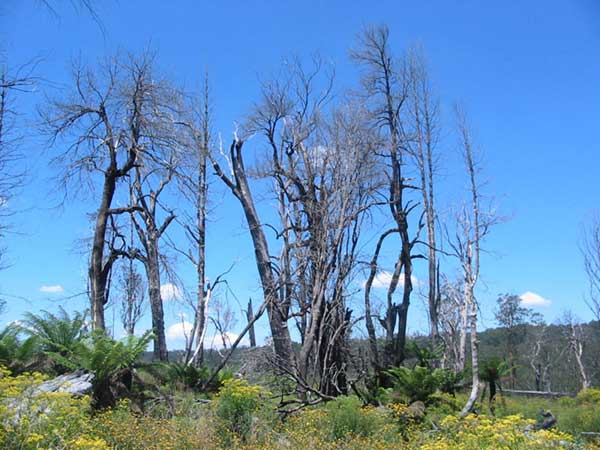
Small rainforest stand destroyed by fire as a part of a clearfell logging operation in East Gippsland at East Errinundra RSOS 81 in 2001. Photo taken in 2005.
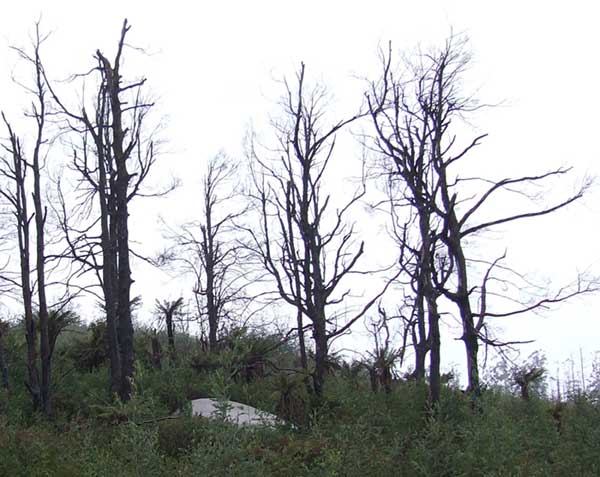
Cool Temperate rainforest stand destroyed by fire as a part of a clearfell logging operation at Mt Baw Baw 2004.
Why is this rainforest destruction currently sanctioned by the Victorian Government? See below.
Rainforest made vulnerable by logging
The next images shows how no buffer was put between a small stands of rainforest.
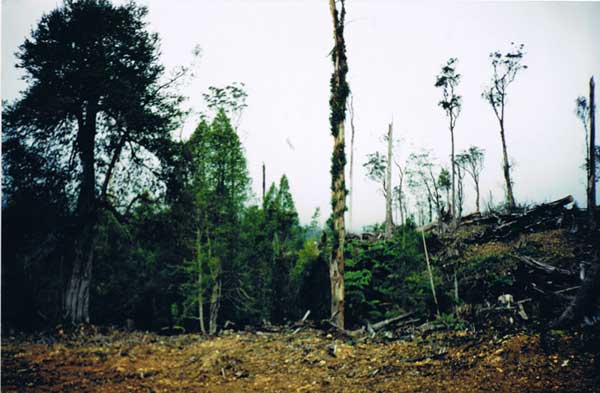
Clearfell logging on the Errinundra Plateau(East Gippsland) mid 1990's next to Cool Temperate Rainforest with no buffer. The trees with the pointy tops are southern sassafrass that make up the primary rainforest canopy. It is not know if this rainforest survived the logging operation.
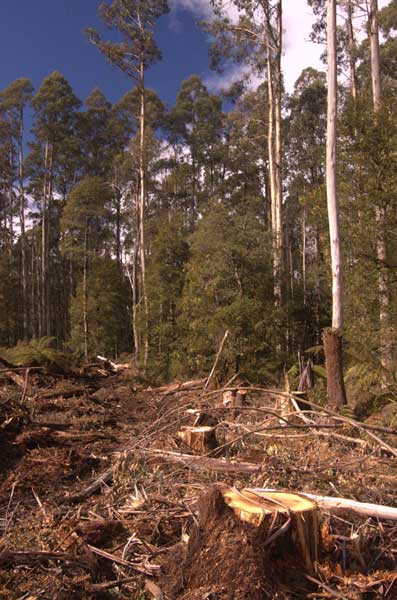
No rainforest buffer has been applied to protect this stand of mixed rainforest myrtle beech trees near Mt Baw Baw. Photo taken in August 2006
There are some areas of East Gippsland and the Central Highlands which have higher resolution within Google Earth where individual trees can be seen. Clearfell logging and rainforest stands can be made out in these areas.
The image below shows what appears to be logging too close to rainforest and in breach of the 1996 Code of Forest Practices for Timber Production.
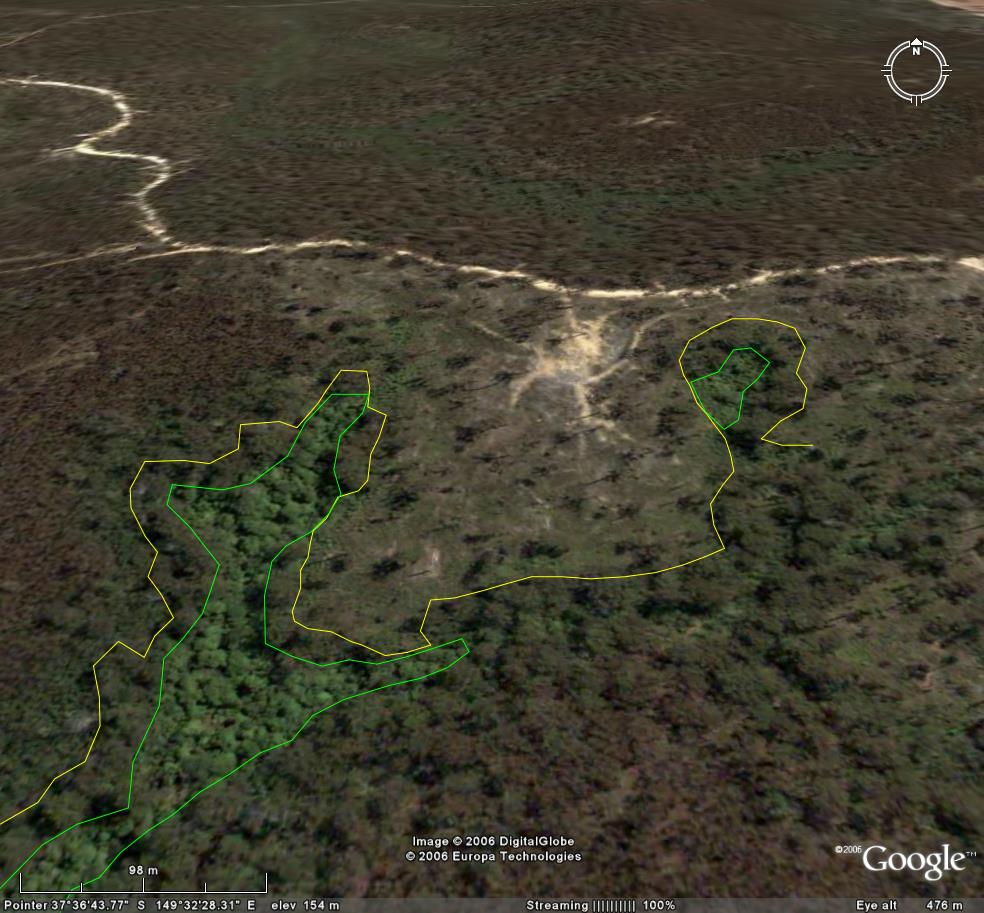
Example of clearfell logging next to rainforest in East Gippsland. Where the green and yellow lines meet, no rainforest buffer has been applied.
This is an alledged breach of the Victorian Governments own rules.
Do your own rainforest audit of clearfell logging near rainforest using Google Earth. See for yourself if clearfell logging breached rainforest buffer guidelines.
Poor identification means rainforest is still destroyed by clearfell logging practices
Inappropriate rainforest identification on public land in Victoria is allowing rainforest communities to be destroyed by logging practices in breach of the government own Code of Forest Practices. This destruction is currently sanctioned by the State Government due to conflicting definitions and contradicting management strategies. The primary issues are:
- DSE has failed to formally
accept the Flora and Fauna Guarantee Act definition for rainforest. As a result there has been little recognition of mixed forest(mixed rainforest) so logging can continue to exploit wood resources within this rainforest type.
See more.
- DSE currently condones the
destruction of rainforest communities that are less than 0.4 ha by logging
operations, which is in breach of the Code. See below
- The State Wide Management
Procedures for rainforest contain rainforest identification instructions
that are inconsistent with the Code and full of contradictions.
See below
Destruction of rainforest less than 0.4 ha
The intended purpose of Section 2.3.7 of the 1996 Code of Forest Practices is to protect all rainforest no matter what its size.
The Code states:
"Rainforest must be excluded from timber harvesting and, because rainforest communities may be particularly vulnerable to adjacent disturbance, they should be surrounded by an appropriate buffer".
However DSE has a policy in East Gippsland and the Central Highlands to exclude small communities of rainforest under 0.4 ha in size as well as small linear strips along creeks from receiving a buffer during logging operations. VRN believes the practice of logging areas less that 0.4 ha is a breach of the Code and in violation of FFG Act Nomination 207.
Small rainforest stands under 0.4 ha are totally destroyed in the artificial regeneration burn after logging because there are no buffers. Hence it is a fact that rainforest is being routinely destroyed as a result of logging practices condoned by the government and despite the Code.
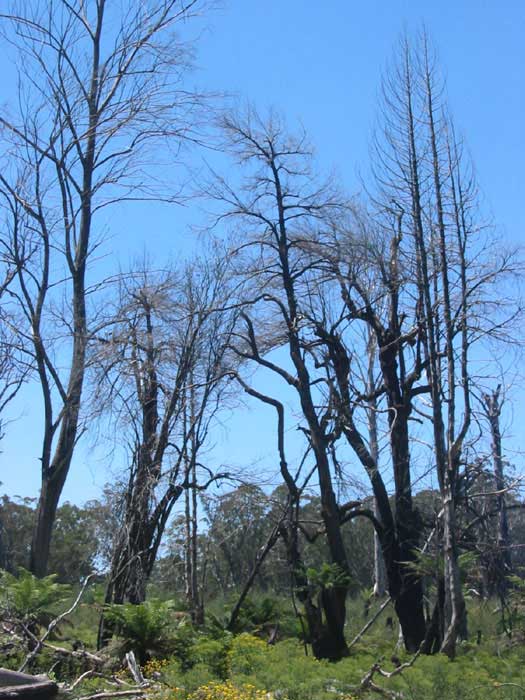
Small rainforest stand less that 0.4ha destroyed as a part of a clearfell logging operation at East Errinundra RSOS 81 in 2001. Photo taken by VRN in January 2005.

Cool Temperate rainforest stand destroyed by fire as a part of a clearfell logging operation at Mt Baw Baw in 2004. Photo taken by VRN in September 2006.
The images above are proof that the Victorian government or the native forest logging industry cannot claim that all rainforest on public land is protected from logging operations when clearly there are "rules" that exclude small rainforest communities less than 0.4 ha in size from receiving protection.
DSE offers the argument that rainforest is not rainforest because a prescription. However the very fact that a prescription exists within the State Wide Management Procedures to exclude rainforest communities under 0.4 ha in size, is in itself an acknowledgment that rainforest communities less than 0.4 ha in fact do exist.
Victoria has an estimated 15,800 hectares of mature rainforest containing over 4,100 small patches. ( Rainforest in Victoria - a review of the scientific basis of current and proposed protection measures , Department of Conservation and Natural Resources, 1995).
So, of all these small patches, how many are less than 0.4 hectares? The
Code must make it clear that it applies to a rainforest "community"
State Wide Management Procedures contradictions.
The State Wide Management Procedures demonstrate a high level of inconsistencies and contradictions in the way rainforest is recognised across Victoria, an issue the Code needs to address. These are:
The State Wide Management Procedures provide a process to identify rainforest communities for East Gippsland (See Management Procedures 4.8.2(a)) and the Central Highlands (See Management Procedures 4.8.3(a)) based on the rainforest indicator species present.
However if the rainforest community fails to meet the "size criteria" of the State Wide Management Procedures 4.8.2(c) and 4.8.3(c) for East Gippsland and the Central Highlands respectively, then it is not considered rainforest and describe as a "stand" of trees rather that than a "community" of rainforest plants as outlined in 4.8.2(a) & 4.8.3(a). This contradiction suits a commercial point of view rather than ecological functioning.
The State Wide Management Procedures for the Otways provide a directive to use the David Cameron guideline to identify rainforest but in contrast to East Gippsland and the Central Highlands, provide no limit on the size that rainforest needs to be.
From a practical point of view it is possible to protect all smaller rainforest communities. In the Otways all rainforest comminutes less than 0.4 ha were routinely protected from logging. A good example was at the Browntown coupe within the Aire-Young's Creek National Rainforest Sites of Significance. In 2002, rainforest experts David Cameron and Mark Burgman, along with conservationists and DSE attended a Otway field trip to teach forestry officers to identify rainforest buffers at the Browntown coupe for a community less than 0.4 ha in size. There are many examples in the Otways where very small rainforest communities were preserved.
The Code should make a directive that the very existence of rainforest communities is the criteria for protection and appropriate buffer, rather than the nominating the size of a rainforest community.
Woodchip Tour
Go on an export woodchip tour from the forests of East Gippsland to the huge industrial pulp mills in Japan (owned by Nippon Paper) via the export mill in Geelong called Midway Pty Ltd.